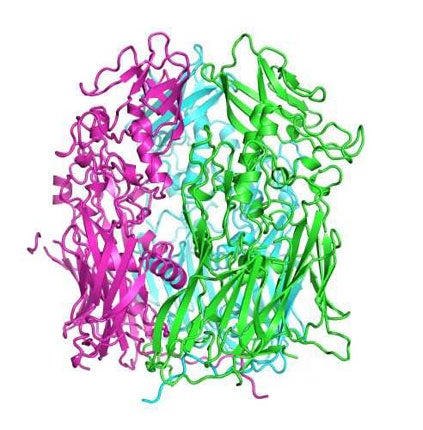Virus-busting radiation beam offers hope to flu sufferers
New technique enables scientists to paint accurate portrait of deadly infections

Scientists have developed a technique for studying one of mankind's oldest enemies – the virus – which could help them treat some of the most difficult and intractable infections in the world.
Viral infections, from influenza to Ebola, have proven to be difficult or impossible to treat effectively because most modern drugs, apart from some vaccines, are ineffective.
But now scientists have developed a revolutionary way of examining a virus which they believe could provide new ways of developing antiviral drugs that will work as effectively on viral diseases as antibiotics have worked on killing bacteria. The method works by shining intense, ultra-thin beams of a special light called synchrotron radiation on a virus, enabling scientists to build up a three-dimensional, sub-microscopic image of the protein building-blocks that make up the infectious agent.
Synchrotron light is so powerful it allows researchers to paint accurate portraits of the otherwise invisible biological molecules that form the protective shells and inner machinery of viruses – the simplest yet most lethal of parasitical lifeforms.
By solving the three-dimensional structures of these viral proteins,scientists hope to overhaul the way viruses are studied and classified. They expect in the process to invent radically novel ways of fighting them, with tailor-made drugs and genetic therapies.
The latest breakthrough came yesterday with the announcement that scientists at the Diamond synchrotron light source in Oxfordshire have solved the structure of a biological protein at the heart of the vaccinia virus. That virus is a member of the family of poxviruses that was used to create the smallpox vaccine.
By picturing the precise spatial arrangement of the atoms within the protein, the researchers demonstrated that this complicated poxvirus is in fact related to a larger number of simpler viruses, which have all derived from a common ancestor following the rules of Darwinian evolution.
Professor Dave Stuart, director of life sciences at Diamond, which is Britain's national synchrotron machine, said the insight provided by investigating viruses in this way could open up the study of these dangerous infectious agents, eventually leading to a revolution in the science of virology.
"Viruses are by their very nature extremely hard to classify. They are much more common and diverse than any other form of life. On top of this, they evolve about one million times quicker than animals and we have no fossils to help us track their evolution back through history," he said.
"Determining the structure of proteins is our best approximation to a fossil record, and knowing more about virus families and the relationships between these families will help us to develop new, more effective, therapies," he told the American Association for the Advancement of Science in Chicago.
It is estimated there are 10 times as many viruses as all other lifeforms put together, "Yet there is no tree of life for viruses," Professor Stuart said.
Because viruses are so small and replicate so fast, it has until now been almost impossible to build up accurate evolutionary trees portraying the story of how a group of apparently unrelated viruses has evolved from a common ancestral stock. However, the latest vaccinia virus research coming out of the Diamond laboratory has given fresh impetus to a new approach to drawing up family trees of viruses, Professor Stuart said.
"We have been able to confirm our theories about the vaccinia virus at Diamond. This is a step towards a reclassification of the virus world, which can guide the way we think about therapies in the future," Professor Stuart said. "Currently, with viruses such as HIV, the therapies are targeting the replication machinery of the virus, rather than their shells.
However, he added: "If structural commonalities between viruses are known, these links can be used to create therapies that work on a family of viruses, as opposed to just one."
Subscribe to Independent Premium to bookmark this article
Want to bookmark your favourite articles and stories to read or reference later? Start your Independent Premium subscription today.

Join our commenting forum
Join thought-provoking conversations, follow other Independent readers and see their replies